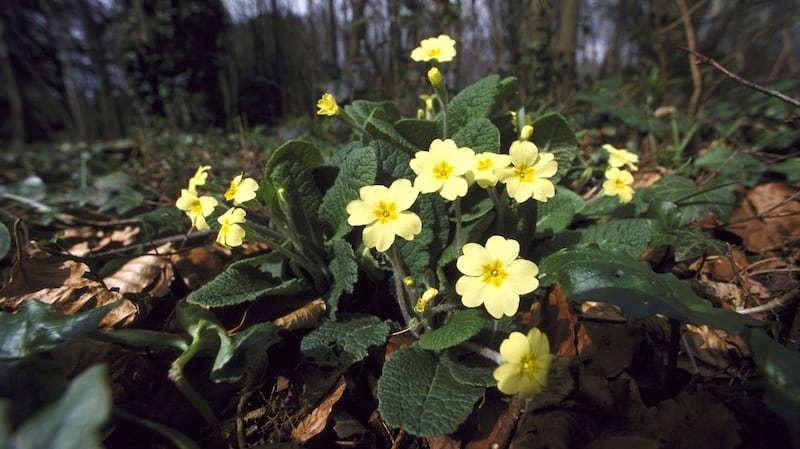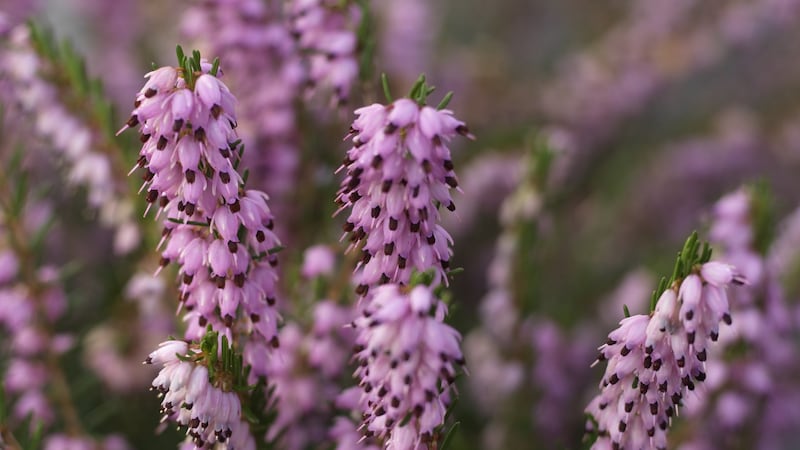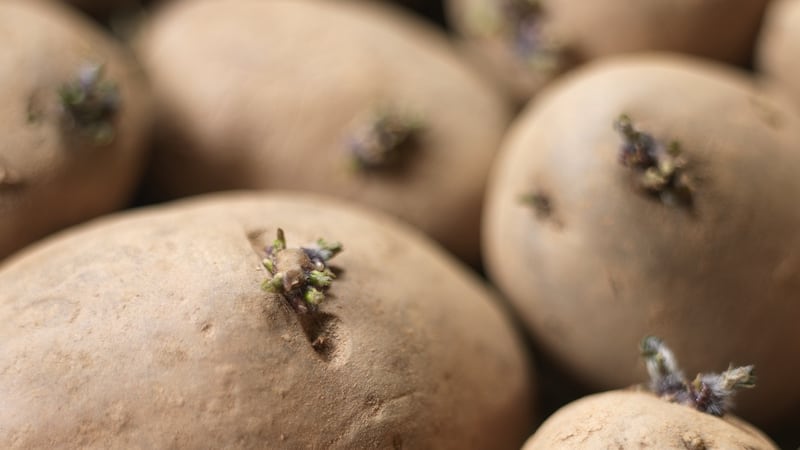I spotted the first flush of wild primroses flowering in nearby woods a few weeks ago. Speckled along the edges of a steep, damp bank that sits beneath the dappled shade of beech trees, their blooms glimmering like gold coins in a fountain, it was a joy-inducing sight that stopped me in my tracks and had me stooping low to touch those luminous, lemon-yellow flowers and inhale their sweet, clean perfume.
Widespread throughout Ireland, few plants are as unassumingly charming as this hardy, spring-blooming, native perennial wildflower. It is often found growing along damp ditches, grassy roadsides and shady hedgerows where it will generously self-seed over time to gradually form large colonies, especially on heavier, moisture-retentive but well-drained, neutral or mildly acidic soils.
In a garden setting, primroses will also happily grow beneath the skirts of deciduous trees and shrubs or along the side of a hedge, but where space is tight you could grow these ultra-compact perennials in a shady window-box combined with violas, hellebores, dwarf narcissi and crocuses for a pretty, seasonal display.
Not only are their dainty spring blooms hugely decorative, they are also edible. Painted with the lightest slick of egg-white and then covered with a dusting of caster sugar, crystallised primrose flowers can be used as the prettiest of decorations on cakes, desserts and puddings. The plant’s gently puckered, tongue-shaped leaves are also edible and can be used either raw in a salad or added to a soup, although harvesting these in any quantity is not something I’d recommend if you want your primroses to flourish.
Human foragers aside, these luminous spring flowers are appreciated by early-foraging bees, moths and other pollinating insects. Look very closely at a colony of plants in full bloom and you'll also see what so fascinated the plant scientist and botanist Charles Darwin. The primrose typically produces, in a roughly 50:50 ratio, two subtly different types of flowers known as "thrum-eyed" and "pin-eyed", a natural adaptation which ensures successful cross-pollination via visiting bees, moths and other emerging insects on the hunt for spring nectar.

That naturally promiscuous inclination of most primula species to cross-pollinate and hybridise has been used to great advantage by plant breeders, especially in the Victorian era and the early twentieth century. The result is primroses with flowers in a remarkably rich variety of colours – from blood-red, papal purple, flame yellow and fiery orange to coral, apricot, snow-white and dusty pink- – as well as some with handsome dark leaves or highly decorative, double flowers (flowers with lots of petals), many of which make lovely garden plants.
Amongst these are historic primrose varieties, including what are known as Jack-in-the-green types where each flower is surrounded by a small, decorative ruff of green leaves and the “hose-in-hose” kinds where each flower appears to be cocooned inside another. Other old but enduringly popular primrose varieties include the vigorous “Wanda” (yellow-eyed, cardinal-purple flowers) and Primula “Guinevere”, a very pretty, historic Irish variety with dusty pink flowers and bronze foliage.
Since the 1930s when its original owner Florence Bellis began breeding primroses through a rigorous process of hand pollination, the famous nursery known as Barnhaven Primroses (barnhaven.com , now based in France) has been responsible for introducing many choice types of primroses into cultivation including many exquisite doubles such as "Elizabeth Killelay" (dark red flowers edged with gold); "Burgundy Ice" (chocolate-red flowers edged with silver) and "Miss Indigo" (violet-purple edged with white).
Unlike their wild cousins, most of these double primroses are demanding plants that need rich, fertile soil enriched with generous annual mulches of manure, homemade garden compost or homemade leaf-mould but are extremely floriferous as long as they are regularly deadheaded and divided every two years to keep them happy.
Ireland also has its own unique history of breeding primroses; the best known are popularly known as the Kennedy primroses. Raised by the Carlow-born gardener and amateur primula-breeder Joe Kennedy over many decades using centuries-old varieties collected from Irish gardens and developed by Kilkenny-based FitzGerald Nurseries using modern micro-propagation techniques, the range includes "Gilded Garnet" (double burgundy flowers laced with gold); "Innisfree" (chocolate-red leaves and blood-red flowers with a golden eye); and "Drumcliffe" (chocolate coloured leaves and white flowers with a golden eye, flushed with dusty pink). Available to buy from good garden centres here in Ireland as well as in Europe and the UK, they fly the flag for what is one of our loveliest and most resilient spring wildflowers.

Aside from potted plants purchased from a garden centre or specialist nursery, raising your very own primroses from seed is an excellent way to acquire large numbers of these pretty plants for your garden. If it's wild Irish primroses that you're after, then it's best to propagate them from fresh, Irish-grown seed (suppliers include mrmiddleton.com and wildflowers.ie) sown in spring. But whatever you do, resist the temptation to dig up plants from the wild.
The native Irish primrose aside, Barnhaven Primroses also sell selected seeds of many named and unnamed varieties of primrose including some older varieties. When sowing, bear in mind that primula seed needs light and air to successfully trigger germination, so surface-sow using a good-quality, damp, fibrous seed compost top-dressed with a dusting of vermiculite. Place the seed tray outdoors in a cool spot (ideally between 12-15 degrees and no warmer than 18 degrees) out of direct sunlight and water regularly to ensure it doesn’t dry out. The first seedlings should appear within a matter of weeks and, given the primrose’s promiscuous habits, are almost certain to contain some beautiful surprises.
Other specialist online suppliers of primrose plants include Ballyrobert Gardens (ballyrobertgardens.com) in Co Antrim.
This Week in the Garden
March is one of the busiest months of the gardening year as regards raising young plants from seed. Where possible, try to source organically-certified seed as these will be free from environmentally-harmful treatments including neonics/ neonicotinoids which are harmful to pollinating insects as well as to soil life. Recommended Irish organic seed producers include Cork-based Brown Envelope Seeds (brownenvelopeseeds.com) and Irish Seed Savers (irishseedsavers.ie). For reasons of sustainability, try to use a good-quality, fine-grade organic peat-free seed compost such as Klasmann, which is available to order online from Irish suppliers such as quickcrop.ie and fruithillfarm.com.

Growing some early spring flowering plants is another great way for gardeners to play their part in reversing the ongoing decline in the numbers of pollinating insects. Examples of valuable nectar/ pollen plants in decorative flower in Irish gardens at this time of year include hellebores, lungwort (pulmonaria), winter aconite, winter-flowering heather (erica), primroses, snowdrops, mahonia, crocuses, winter honeysuckle and willow. For further information on planting for pollinators, why not come along to the National Botanic Gardens in Glasnevin today (2.30-3.30pm) where the expert beekeeper and editor of the beekeeping journal An Beachaire, Mary Montaut, will be giving a talk "Planting with Bees (and other Pollinators) in Mind" on behalf of the Irish Garden Plant Society. See botanicgardens.iefor details.

If you're planning on planting potatoes in your kitchen garden or allotment in the coming weeks, then "chitting" the tubers for a few weeks is a good way to speed them into growth, resulting in an earlier harvest and improving the plants' chances of escaping the dreaded potato blight. Chitting is a simple process of placing the seed potatoes in an egg-box or shallow seed tray in a cool, bright room for several weeks until the "eyes" break into bud. Most good garden centres carry a range of seed potatoes while recommended Irish online suppliers carrying a wide range of different varieties include mrmiddleton.com and fruithillfarm.com.
Dates For Your Diary
Tuesday 5th March (8pm), St Patrick's Recreation Centre, Church Road, Greystones, Co Wicklow. Delgany & District Horticultural Society's annual spring lecture with guest speakers Jim and Joan Gregg, all welcome. See delganydhs.com.
Also March 5th (8pm), Northridge House, St Luke's Home, Mahon, Co Cork. "Tasmanian Plants for Irish Gardens", a talk by Neil Porteous, head gardener of Mount Stewart Gardens in County Down on behalf of the Irish Garden Plant Society IGPS), admission free for IGPS members/€5 for non-members. See irishgardenplantsociety.com.




















